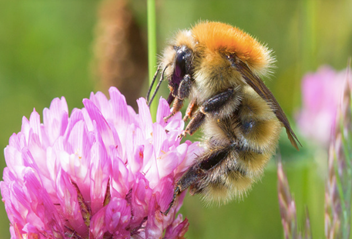Tipperary dairy farmer, John Fogarty, discusses the management of hedgerows to help pollinators on farms in a new video from Tipperary County Council.
“I think if we realised all the fruits we would be missing in our hedgerows if we didn’t have pollinators, we might treat them a little bit better,” John said.
I try and manage the hedges to help the pollinators, give the trees a chance to flower. An awful lot of trees and shrubs will only flower on two-year-old wood. If you flail them or cut them every year, you won’t have any flowers; therefore, you won’t have any fruits. And it all plays into the life cycle of the insects.
“If the flowers aren’t there, they have no pollen to rear their young. And after two years, they’re gone as well – maybe even after 12 months,” said John.
Growers
Pollinating insects, such as our bumblebees and solitary bees, provide important pollination services for fruit, vegetable and rapeseed growers in Ireland.
Without enough flowers in the landscape, bees are in decline, with one-third now at risk of extinction. By allowing hedgerows to flower, this would go a long way towards saving the bees, according to the National Biodiversity Data Centre.
In spring, bees and other pollinators need to feed on the pollen and nectar produced by the hedgerow’s wild flowering plants, such as the maybush or hawthorn, blackthorn, willow and dandelions.
In late summer and autumn, the hedgerow’s bramble and ivy provide vital food for queen bumblebees that must fatten up to hibernate over winter.
Acclimatised
Our management of hedgerows, John said, has changed greatly since he was a child. “We’ve become acclimatised now to having our hedges cut and the lack of insects on our hedges,” he said.
I also think that hedgerows are very important from the point of view of shelter, both for animals and for stock and for buildings. We’ve had a lot of storms over the last number of years and I think a lot of farmyards would have benefitted greatly from a hedgerow near them to provide shelter for their buildings and their stock.
“I would be very confident that managing hedgerows as I do hasn’t really cost me anything. I’m not getting paid to do it either. To me, it’s just the natural way they should be.”
The All-Ireland pollinator plan – www.pollinators.ie – offers tips on managing a pollinator-friendly hedgerow.
- Leave at least one mature whitethorn or blackthorn tree within each hedgerow.
- Where possible, cut hedgerows on a three-year cycle. Cutting annually stops the hedgerow flowering and fruiting.
- Where possible, cut in rotation rather than all at once as this will ensure some areas of hedgerow on your farm will always flower. Blackthorn is white in March. Whitethorn flowers at silage time in May.
- Hedges managed for pollinators should ideally be cut between November and January, in an A-shape. If they must be cut outside this, cut in rotation, so some areas remain undisturbed.
- Let some bramble and ivy grow in hedgerows. They are key nectar and pollen sources in summer and autumn.
- Where hedgerows must be cut along the roadside for safety, allow the inside to flower.
- Aim for a hedgerow that is as high as possible, but at least 2.5m above ground level or above the bank.
- Let some of your hedgerows grow wild, side-trimming only.
- Avoid spraying the hedgerow base. Use mechanical weed control and spot-spray only in exceptional cases.
- Leave an unfertilised buffer margin at the hedgerow base to encourage wildflowers which do better in nutrient-poor soil.
To find out more about how to manage hedgerows for pollinating insects, and download the farmland guidelines ‘Farmland: Actions to help Pollinators’, visit: www.pollinators.ie.
